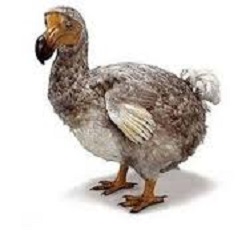New research suggests that the dodo, an extinct bird whose name has entered popular culture as a symbol of stupidity, was actually fairly smart. The work, finds that the overall size of the dodo’s brain in relation to its body size was on par with its closest living relatives: pigeons–birds whose ability to be trained implies a moderate level of intelligence. The researchers also discovered that the dodo had an enlarged olfactory bulb — the part of the brain responsible for smelling — an uncharacteristic trait for birds, which usually concentrate their brainpower into eyesight.
“When the island was discovered in the late 1500s, the dodos living there had no fear of humans and they were herded onto boats and used as fresh meat for sailors,” said Eugenia Gold, the lead author of the paper.
“Because of that behavior and invasive species that were introduced to the island, they disappeared in less than 100 years after humans arrived. Today, they are almost exclusively known for becoming extinct, and I think that’s why we’ve given them this reputation of being dumb.”
When comparing the size of the birds’ brains to their body sizes, Gold and collaborators found that the dodo was “right on the line.”
“It’s not impressively large or impressively small — it’s exactly the size you would predict it to be for its body size,” Gold said. “So if you take brain size as a proxy for intelligence, dodos probably had a similar intelligence level to pigeons. Of course, there’s more to intelligence than just overall brain size, but this gives us a basic measure.”
The study also revealed that both the dodo and the Rodrigues solitaire, which recently was driven to extinction by human activity, had large and differentiated olfactory bulbs. In general, birds depend much more on sight rather than smell to navigate through their world, and as a result, they tend to have larger optic lobes than olfactory bulbs. The authors suggest that, because dodos and solitaires were ground-dwellers, they relied on smell to find food, which might have included fruit, small land vertebrates, and marine animals like shellfish.
“It is really amazing what new technologies can bring to old museum specimens,” said co-author Mark Norell, Macaulay Curator of Paleontology. “This really underscores the need for the maintenance and growth of natural history collections, because who knows what’s next.”
The researchers also discovered an unusual curvature of the dodo’s semicircular canal — the balance organs located in the ear. But as of yet, there’s not a good hypothesis for this atypical feature.
Source: Science daily
N.H.Kh

